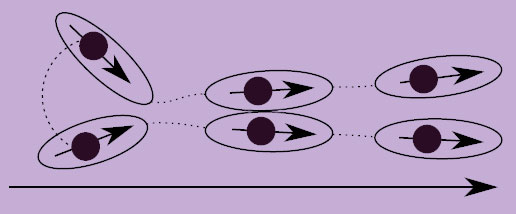
A connection between fluids containing self-propelling particles and the fundamentals of quantum mechanics has been discovered by Benjamin Loewe, Anton Souslov and Paul Goldbart at the Georgia Institute of Technology in the US. This insight allowed the team to derive hydrodynamic equations describing active fluids, something that had proven very difficult to do in the past.
Fluid dynamics cannot always be described by the random motions of individual particles. When self-propelling particles – such as swimming bacteria – are involved, orderly, spontaneous flows can occur on a large scale. Known as active fluids, these substances are unique states of matter.
To better understand self-propelling particles, the Georgia trio modelled them as rice-shaped grains with two fundamental properties dictating their dynamics – the directions in which they move and rotate. Loewe’s team saw that these two properties were fundamentally linked; that a grain’s direction of travel depends directly on where it points, and vice versa.
Adapted Schrödinger equation
Such a description has strong similarities with the quantum-mechanical rule of spin-orbit coupling, in which the spin and orbital angular momentum of quantum particles are fundamentally linked. Pursuing this analogy, Loewe’s team adapted the Schrödinger equation – the central principle describing the dynamics of quantum systems – to instead describe the dynamics of self-propelling particles.
Scaling the problem up, the researchers adapted the Schrödinger equation further to build a hydrodynamic description of the behaviour of many self-propelling particles in a fluid. The trio successfully derived the properties used to characterize fluids, including viscosity, diffusivity and compressibility. However, unlike regular fluids, their equation showed that the grains could spontaneously align, giving rise to orderly flows in 2D – a perfect description of active fluids.
Describing their work in a paper published in the New Journal of Physics, the physicists say their insights could help “realize exotic phases of matter using active fluids via analogies with systems composed of strongly correlated electrons”.



